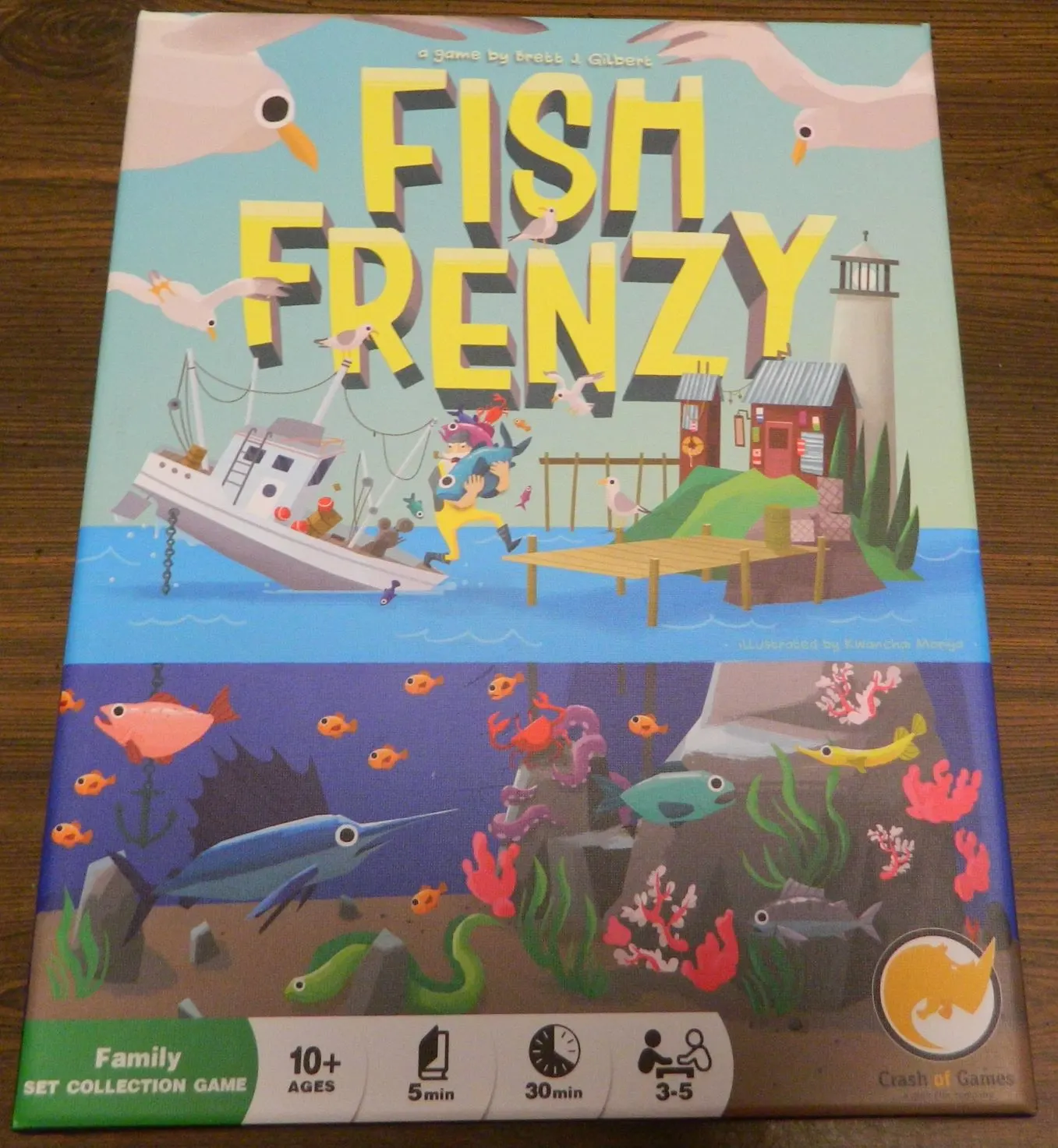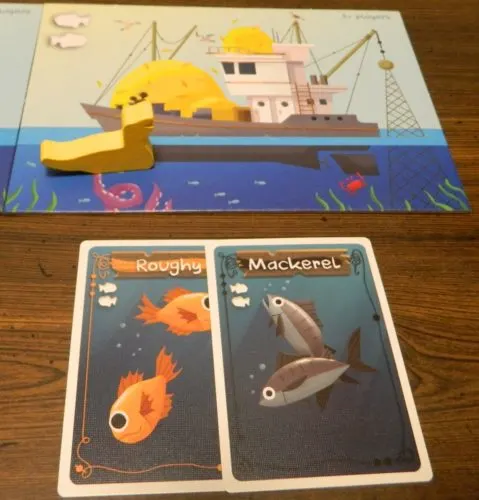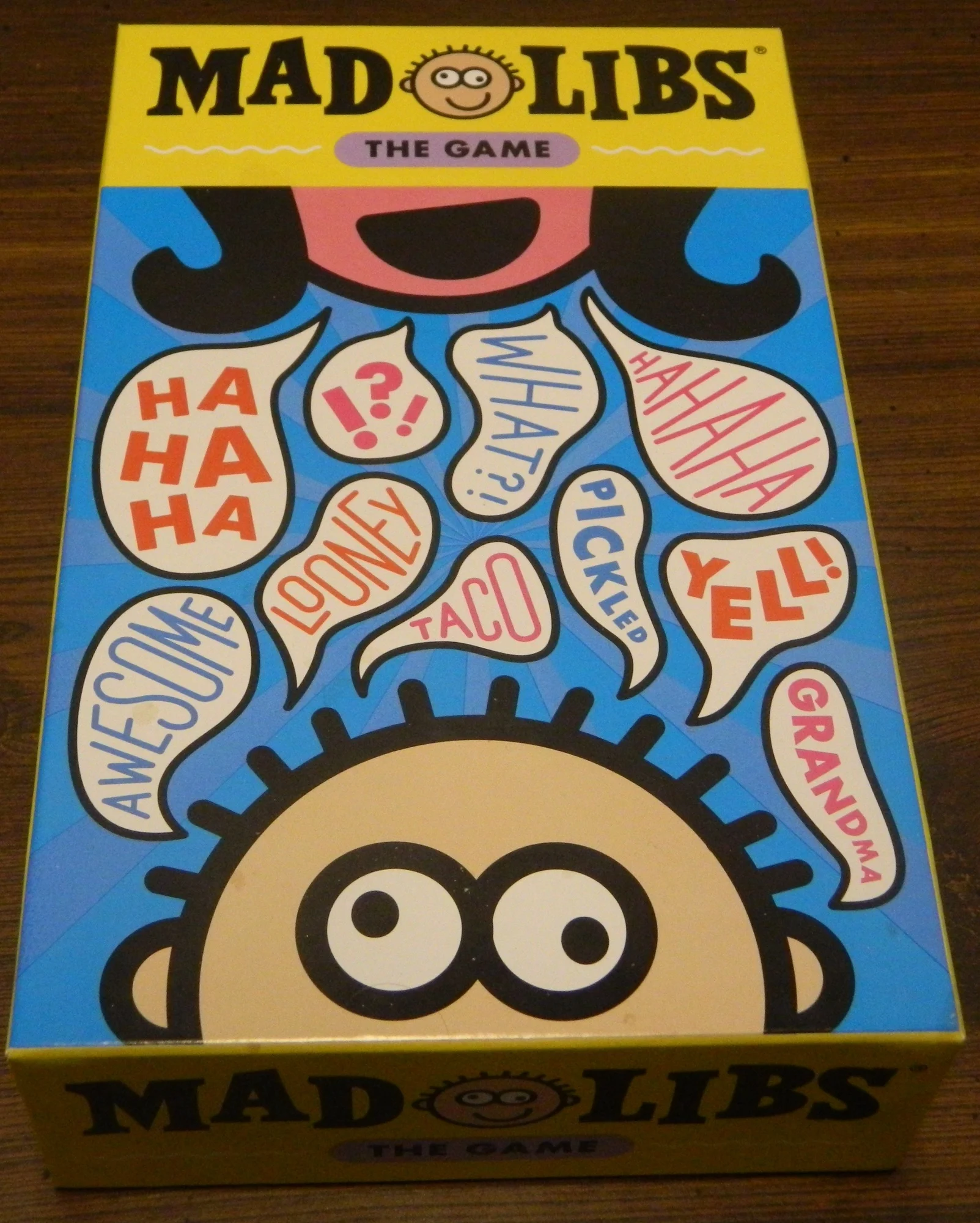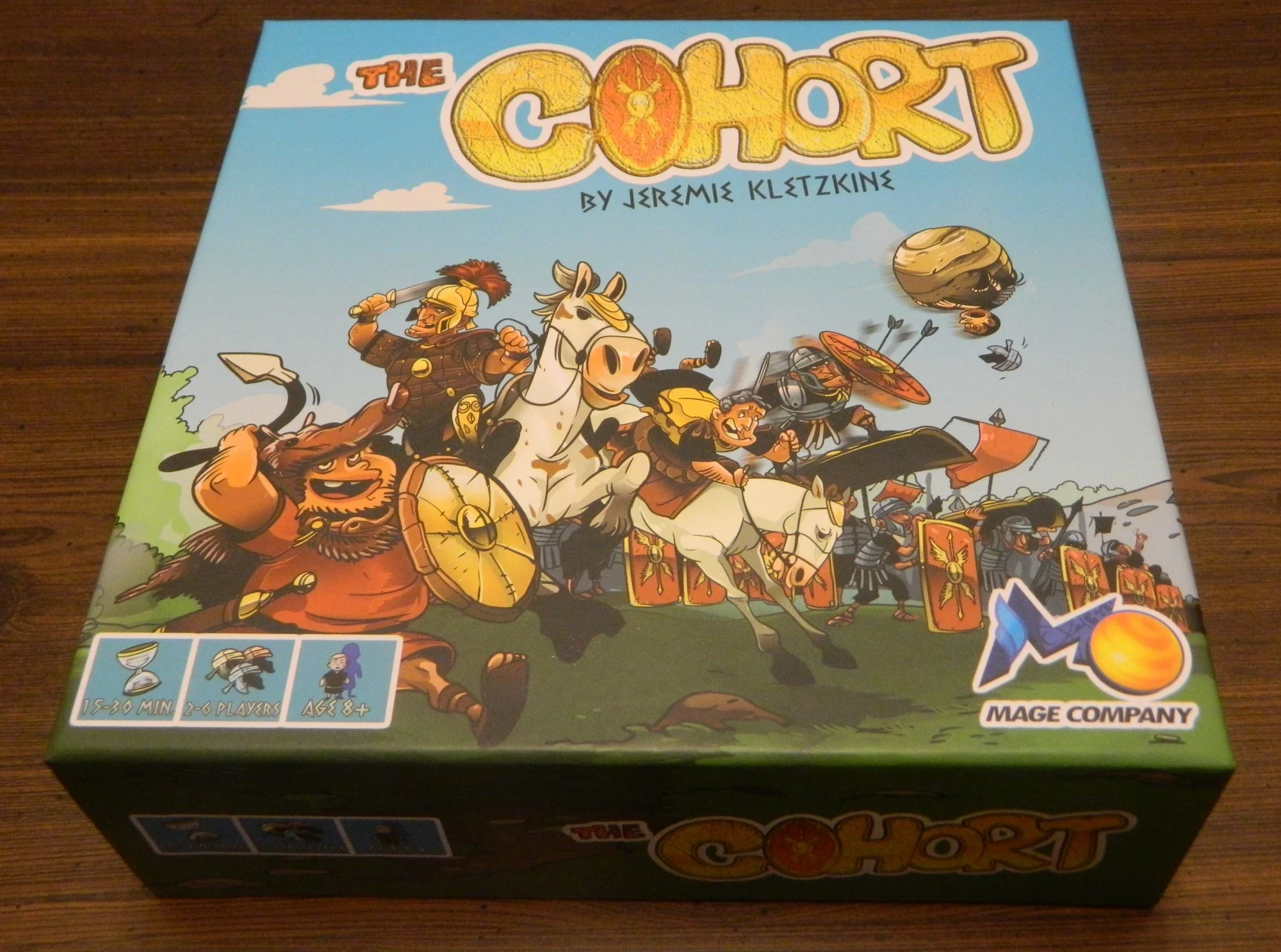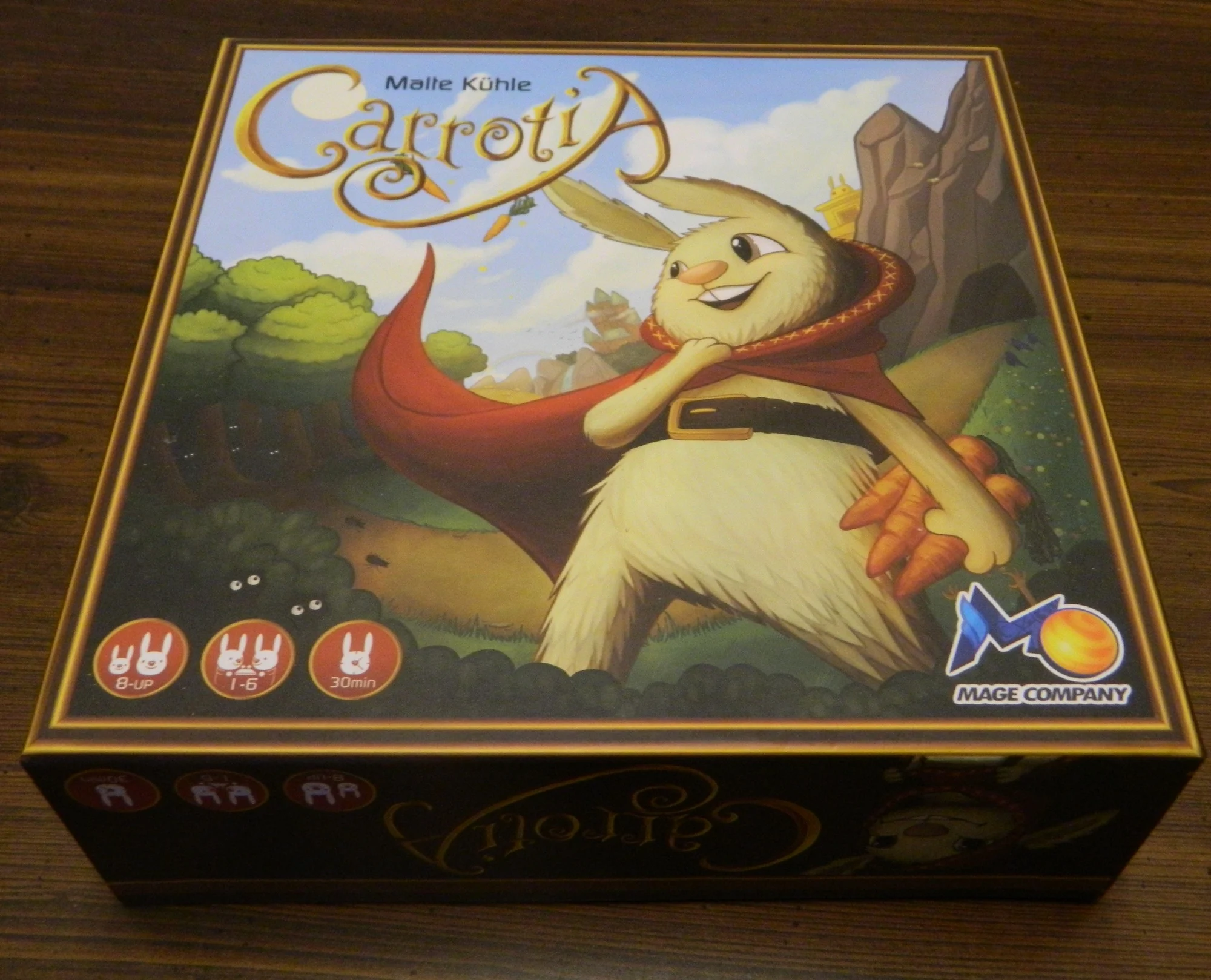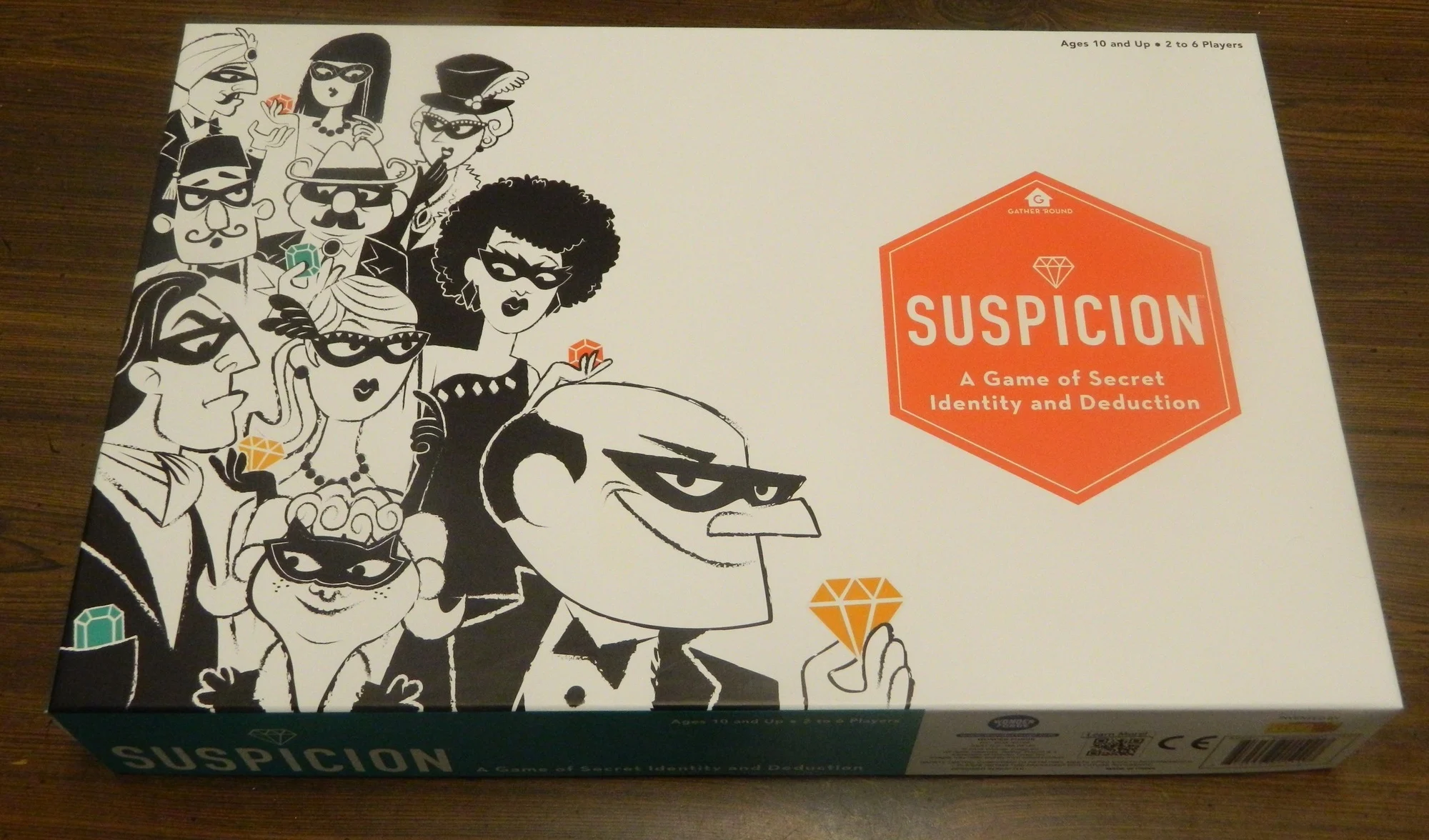In Fish Frenzy each player takes on the role of a seagull. In the town of Rainbow Bay each day the fisherman return to port with their boats full of various types of fish. Eagerly waiting are the town’s seagulls. As a hungry and kind of greedy seagull you want to beat out the other seagulls to collect the most fish of many different types. These seagulls are sneaky though as they can steal your fish right out in front of you. You need to be clever to position your seagull in order to get the most fish while also denying your competition the fish they desire. Fish Frenzy is a 2016 family set collecting bidding game designed by Brett J. Gilbert who is most known for co-designing the board game Elysium. Despite being a somewhat recent game Fish Frenzy has flown under the radar as I had never heard of it until I saw it in an online board game clearance sale. Due to the colorful art style and the fact that I love set collecting games I wanted to check it out. Fish Frenzy is an interesting combination of set collecting and bidding mechanics that lead to a fun game that is probably a better fit for families than fans of highly strategic games.
How to Play Fish Frenzy
Setup
- Place a number of boat boards on the table based on the number of players. Which boards you should use for each player count are indicated in the top right corner of the boards. Lay the boards in a row in the middle of the table. Starting from the left place the boards in order starting with the board with the least fish symbols. Any boards that aren’t used are returned to the box.
- Shuffle the Fish and Crab cards and place them face down to form a draw pile.
- Each player chooses a color and takes the seagull token of their chosen color. They will also take four little fish tokens of their chosen color. The rest of the little fish tokens of each player’s color will be placed in the center of the table to create the general supply. The seagulls and fish of colors not chosen by one of the players are returned to the box.
- The youngest player is given the boat token which indicates who will start the next round.
Playing the Game
Fish Frenzy is played over a number of rounds. Each round consists of three phases.
- Deal Fish and Crab Cards
- Play Seagulls
- Sort the Catch
Deal Fish and Crab Cards
Each round begins with adding new Fish and Crab cards to the table. Starting with the boat on the left two cards are taken from the draw deck. These cards are placed face up below each boat. The order of the cards matter so when placing cards you will start from the left and place each additional card to the right of the previous card. If the location becomes too crowded you can overlap cards, but you should do so in a way that players can see the colors of each card.
As you progress through the game there may already be cards underneath a boat from a previous round. The additional cards will be placed to the right of the cards that were already placed on the table.
Play Seagulls
The player with the boat token will begin this phase.
On their turn each player will place their seagull on one of the boats. If no other seagull is on the chosen boat the player’s turn immediately ends and play passes to the next player clockwise.
If the boat that the player placed their seagull on is occupied by another seagull the current player will have to challenge the other player for control of the boat. To challenge the player you will have to place a number of little fish tokens equal to the amount already played by the other player plus one. When you place a seagull on an unoccupied boat you are unable to place any fish tokens along with your seagull.
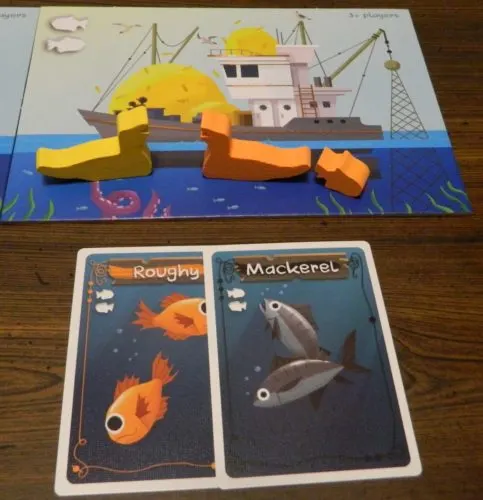
The orange player has decided to challenge the yellow player for control over this boat. To challenge the orange player has to play one fish token to the boat.
The player that was challenged will then immediately get to take another turn. With their turn they can either challenge the player back or move their seagull to another boat. To challenge back the player has to increase their total number of fish to one higher than the player who just challenged them.
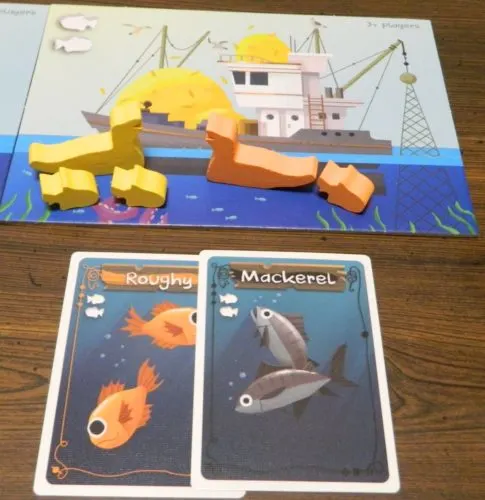
The yellow player has decided to raise their bid for the boat by playing two fish tokens. The orange player will either add two tokens raising their total to three or they will have to move their seagull to another boat.
If they choose to move their seagull they can move it to an unoccupied boat or to another occupied boat and challenge the player on that boat. This process of challenging is the same as the previous challenge. When moving to a new boat if the player had any fish on the previous boat those fish will remain there for the rest of the round.
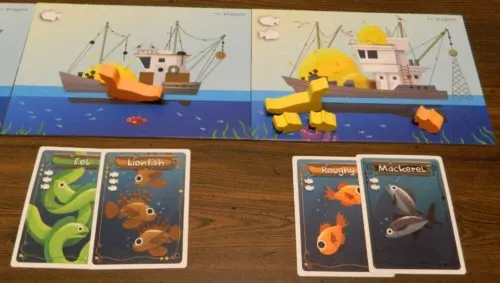
The orange player has decided not to raise their bid to three fish tokens. They decided to move their seagull to another boat. The fish they already played to the other boat will stay there until all of the tokens are removed from the boards.
This process of challenging and moving seagulls continues until the last player in the chain moves their seagull to an unoccupied boat. Play then moves to the first player to the left of the boat token that hasn’t placed their seagull yet. When all of the seagull tokens have been placed on different boats this phase ends.
Sort the Catch
The Sort the Catch phase begins with all of the little fish tokens played in the last phase being returned to the general supply.
Starting with the boat on the left side each player will get to choose what they want to do with their boat. Players can choose one of two actions
First the player can choose to collect cards. When a player chooses to collect cards they will take all of the cards from under their boat. They will place these cards face up in front of themselves. The cards should be sorted based on their types so players can easily see who has the majority of each type.
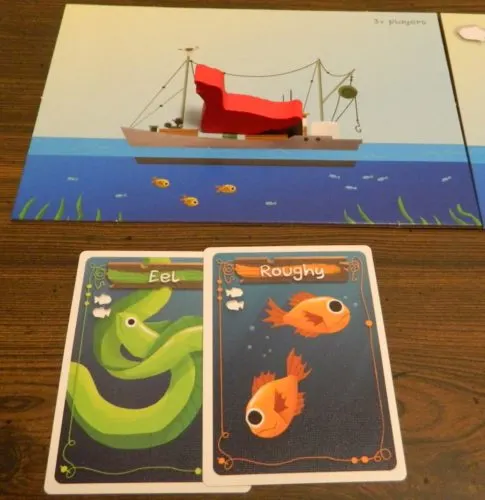
The red player has decided to take the cards from their boat. The player will take the Eel and Roughy card and place them in the corresponding piles in front of themselves.
The other option is to eat. When a player chooses to eat they will look at the card furthest to the right as well as their boat board. Both the card and the boat will feature little fish symbols. The number of little fish symbols between the boat and the right most card determines how many little fish tokens of your color you can take from the general supply. If there are less tokens in the general supply than the amount of tokens you are owed, you will only take the tokens remaining in the general supply. The card on the far right of the boat is then discarded. This ends the player’s action as they don’t get to add any cards to their group of cards.
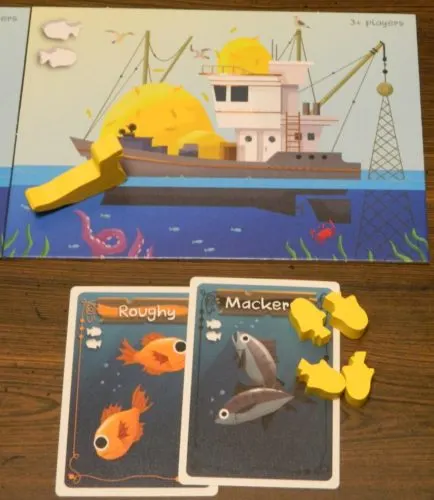
The yellow player has decided to use this boat to eat. They will get a total of four fish tokens. They will get two due to the two fish symbols on the boat board. They will receive two additional fish tokens due to the symbols on the Mackerel card.
When a player has taken their chosen action they will take their seagull token back. The player who claimed the next boat will then get to take their action. This phase will end when all of the players have had a chance to choose an action. If the draw deck still contains cards another round will be played. The boat token will be passed to the next player clockwise.
End of Game
The game will end after a round finishes and there are no cards in the draw deck to replenish the cards during the Deal Fish and Crab Cards phase.
Each player will flip over one of the boat boards to reveal the scoring track on the back. Each player will place their seagull token on the zero space. As players score points they will move their token along the track to keep track of their score.
Players will then compare how many cards they have for each of the types of fish (crab cards are handled separately). The player with the most cards of each fish type will score three points. The player with the second most cards of each fish type will score one point. If there is a tie for the most cards of a particular fish type all of the tied players will score two points and no one will receive points for the second most cards of that type.
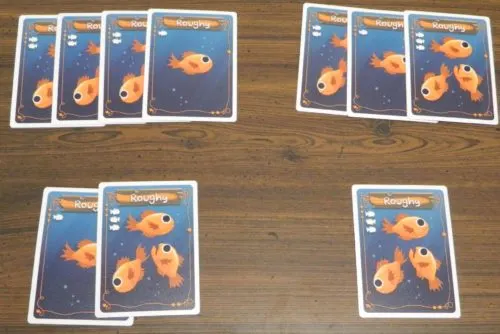
During the game the players have collected the following Roughy cards. The player in the top left has collected the most so they will score three points. The player in the top right has the second most cards so they will score one point.
After the players have done all of the other types of fish they will count up how many crab cards they collected during the game. Players will lose one point for each crab card they collected. Players will not score points for having the most or second most crab cards.
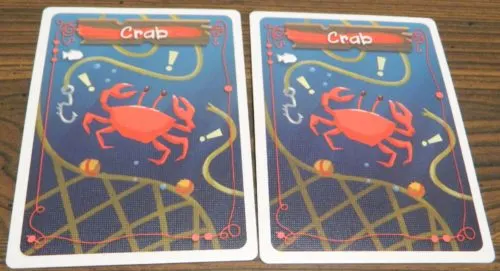
This player has collected two crab cards during the game. They will lose two points from these cards.
The player that scored the most points wins the game. If there is a tie the tied player with the most little fish tokens at the end of the game will break the tie. If there is still a tie the tied player with the least crab cards wins. If the tie still hasn’t been broken the tied players will share the victory.
Goal and Event Cards
A variant rule for the game involves using the goal and event cards. If the players choose to use these cards one card of each type will be randomly chosen for the game. These two cards will apply to all of the players. The goal and event cards give players alternative ways of scoring points during the game.
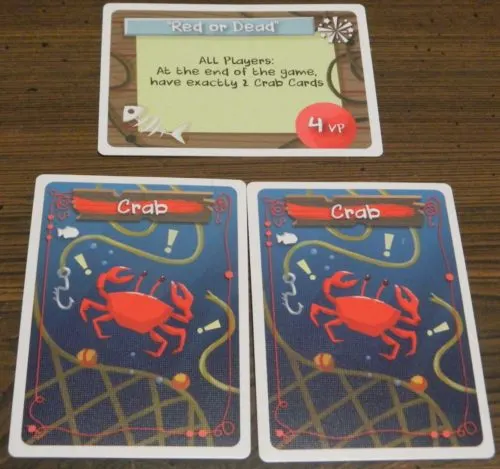
For this bonus card the players had to collect exactly two Crab cards in order to score four bonus points.
My Thoughts on Fish Frenzy
If I were to describe Fish Frenzy’s gameplay I would probably say that it is a combination of a number of different mechanics. The most obvious mechanic is set collecting. Like most set collecting games the main objective in the game is to acquire a lot of cards from a number of different types of fish. To score points you need to either have the most or the second most cards of a particular type of fish. Thus during the game you want to focus on a couple different types of fish as you try to create a majority that the other players can’t beat. As you can always see how many cards of each type that the other players control you need to keep track of who has the majority of each type of fish and how the current cards in play can impact those majorities. During the game you want to maintain your own majorities while also looking for opportunities to take majorities from other players.
For the most part this element of the game doesn’t really differentiate itself all that much from your typical set collecting game. That is not all that surprising as it is hard to find a game that truly innovates the genre as there has been so many different set collecting games that they all mostly follow the same basic principles. I generally like when games do something original and I wish this mechanic was a little more original. It is not a deal breaker though as I am a big fan of set collecting games and Fish Frenzy mostly focused on what I enjoy most about the genre. I wouldn’t say that Fish Frenzy is a really deep game, but you have to put thought into what cards you want to try to take to keep your current majorities while trying to steal majorities from the other players. If you have never really cared for set collecting games Fish Frenzy is unlikely to change your mind. Fans of this genre though should enjoy Fish Frenzy’s set collecting mechanics.
Where Fish Frenzy differentiates itself is that it adds an interesting auction/bidding mechanic to the game. During each round all of the players will get the opportunity to take all of the cards corresponding to one of the boat boards. Players will take turns choosing one of the boats. If a player chooses a boat that no one else wants there is no issue as they can take the boat with no competition. When two or more players want the same boat though things become more interesting. This is where the auction/bidding mechanic comes into play. To place a seagull on an unoccupied boat you don’t have to pay anything. If you want another player’s boat though you will have to compete for it by using one of your little fish tokens. The two players on the boat then fight for the boat by either raising their number of little fish tokens or moving their seagull to a different boat. To get valuable boats players may have to give up quite a few little fish tokens. Players need to decide whether the boat is worth it or if they are better off just choosing their second or third option.
This bidding mechanic is interesting for a couple reasons. I think this mostly comes from the fact that you will always have limited resources to bid with. At any time the max number of tokens that you will be able to bid with is eight. You will usually have considerably less to bid with. In order to get more tokens to bid with you will have to sacrifice one or more of your turns. Therefore you need to wisely choose how you want to use your tokens. You don’t want to put out random bids because you lose all tokens bid even if you don’t get the corresponding boat. This means that you are taking a risk every time you bid for one of the boats. You may have to bid quite a few of your tokens to win a boat and if you lose you will get nothing for all of those tokens. Normally you will bid on a boat because you want the cards for yourself. Sometimes you may consider bidding on a boat to either deny another player cards that they need or just to mess with them by forcing them to use up some of their fish tokens.
The other interesting dynamic with the bidding is that you always know how many fish tokens that the other players have to bid with. Additionally players can only raise the bid by one each time. These two things actually give players an insight into how a bidding war will turn out. By comparing the number of tokens each player has and the fact that you can only raise the bid by one token at a time you will know who will win the bidding if both players bid as much as they can. This gives the player that will win an advantage in the bidding as they know they can win no matter what happens if they are willing to go all of the way. This is more interesting for the other player because they know they will lose unless the other player drops out. The player might choose to immediately move to another boat. They can also choose to stay in the bidding for a while. This allows them to force the other player to use up some of their tokens and maybe they can make the price steep enough that the other player drops out. This adds an element where you have to try to read the other player to see how far they are willing to go in order to keep control over the boat.
Normally the boats aren’t worth getting into a bidding war as there is another boat that is almost as good. There will be times in the game though where you may want to bid whatever it takes to win a boat. If you need a boat to take or maintain control over one of the types of fish it may be worth sacrificing a turn or two to get your fish tokens back. Then there is the fact that boats can start to accumulate quite a few cards. If a boat either has a crab card or multiple players use the boat in order to get fish tokens back, you could have a boat that has five or more cards on it. It somewhat depends on what those cards are, but it is hard to pass up five cards when the other players only get two cards. These additional cards could put you in play for more majorities than if you just took a boat with two cards on it each turn. When boats start to acquire a lot of cards it is not surprising to see players bid all or most of their remaining tokens to maintain control.
For the most part I would consider Fish Frenzy to be a family game. At first glance the game may seem somewhat complicated to people that don’t play a lot of board games. The game does have a number of different mechanics after all. In reality the game is pretty easy to play. The game is simpler than the number of mechanics would indicate. It is more complicated than your typical mainstream game, but I wouldn’t say that it is all that difficult. The game has a number of different mechanics, but they are all pretty straightforward. I think you could explain the game to new players within five minutes and they should pick it up pretty quickly. This leads to the game working well as a family game. The game has a recommended age of 10+, but I think it could work with children a little younger.
I like when games are simple enough where most players should have no trouble playing it. This leads Fish Frenzy’s greatest weaknesses though. The game has some strategy to it as your decisions will have an impact on the game. At times though it just feels like there isn’t a lot to the game. Your decisions in the game are usually pretty obvious to the point where it doesn’t really feel like you even have much of a choice. While playing the game it just felt like something was missing. I still had fun with the game, but I think it could have used something more. I think it will work well for families and people who like lighter games. People who are looking for a really strategic game are likely to be a little disappointed though.
This is one of the reasons that I would highly recommend using the goal and event cards. These cards don’t drastically change the gameplay. They give players something else to consider for their strategy though. In addition to just going for majorities players can pursue other objectives to score points. These can change your priorities in the game leading to a decision that you otherwise wouldn’t normally take. For example one of the cards rewards you for having exactly two crab cards. Normally you want to avoid these cards as they lose you points. With this bonus card though it encourages players to collect two crab cards. Towards the end of the game this becomes pretty interesting as players need to try to place their seagulls in a way to receive exactly two as if you go over you lose the bonus points and receive the normal negative points from the cards. This is just one example as these cards can have an impact on how you would normally play the game.
Another thing that keeps the game interesting is the fact that the scores in the game are usually pretty close. Unless a player doesn’t pay attention to the majorities or focuses too much on just a couple different types of fish they are likely going to be in the running until the very end. Literally in one game I think two players tied for the win with the other players within just a point or two. If just one of the majorities went to a different player the whole outcome would have been different. The scores are close for a couple reasons. First you don’t score a lot of points in the game. Otherwise as most players will get around the same number of cards the players will naturally branch off into their own types of cards. This does a good job spreading out the points between all of the players. Unless you take the time to actually do the math it is very likely you won’t know who is going to win until after the final turn. I like when games keep the scores close as it keeps all of the players interested as no one knows who will win.
As for the components I thought they were pretty good for the most part. I liked the game’s overall atmosphere. The theme kind of feels like it was tacked on. I liked the theme though as it is somewhat unique and I liked the colorful art style. The boards and the cards are thick enough that they feel durable enough to do their jobs. Any regular reader of Geeky Hobbies will know that I am a sucker for wood pieces. Both the seagulls and the fish tokens are made of wood and look like they are custom Meeples. You could have easily used cardboard pieces for the seagulls and fish, but the wood pieces bring some character to the game.
Should You Buy Fish Frenzy?
Fish Frenzy may not be a flashy game, but I found it to be a really solid family game. Basically the game consists of a combination of set collecting and bidding mechanics. The ultimate goal in the game is to acquire the majority of cards of the most different types of fish. There is nothing particularly unique about this set collecting mechanic, but it is still enjoyable. You end up collecting the cards by bidding for control over the ships. This is an interesting little bidding mechanic as each player is guaranteed a boat. Some boats are more coveted than others though so players can bid against one another to try and control the best boats. There is nothing highly original with these mechanics, but there is an interesting dynamic due to you knowing how much the other players can bid and only being able to raise the bid by one at a time. The number of mechanics may look a little overwhelming at first, but the game is overall pretty easy to learn and play. The only real problems with the game is that it doesn’t have any particularly original mechanics and it isn’t the deepest experience. You can have fun with the game, but if you are looking for a game featuring a lot of strategy you may be a little disappointed.
If you aren’t a big fan of family, set collecting, or bidding games Fish Frenzy probably won’t be for you. If the game’s premise sounds interesting though and you don’t mind that it isn’t super deep you can have fun with the game. For a good price I think it is worth picking up Fish Frenzy.

